- Home
- Secondary
- Subject Information
Modern Foreign Languages
Back
Introduction
The Modern Foreign Language department offers students to opportunity to learn Spanish, the second most-spoken language in the world. Young people who have a second language are at a huge advantage in life. It opens doors to new friendships, gives them greater facility to learn extra languages and enables them to think both laterally and creatively.
Aims and Ethos
We aim to provide a fun and positive environment that engages students in developing their language learning skills. Our aim is to make learning enjoyable and to allow all of our students to experience other cultures through active learning, an engaging curriculum and research projects.
With skilled linguists in the department, we are committed to encourage pupils to use the target language with each other in pair or group work and to ensure that pupils are hearing authentic language each time they are in the MFL classroom. Within the MFL classroom we consistently emphasise that it is okay to make mistakes. We believe where pupils learn is in deciding how they move on from these errors. This open environment allows pupils to grow in confidence and not worry about speaking out in front of their peers, and to enjoy broadening their cultural references and in cultural understanding.
Expectations
The MFL department seeks to develop the following in all of our students:
Key Stage 3
- To be culturally aware and know that life and language is different in other parts of the world. They develop effective memory skills. Pupils develop an awareness of time frames.
- To see and apply patterns and think logically about new and previously acquired language in order to develop grammar knowledge and widen their vocabulary. Pupils practice the formation of past, present and future timeframes.
- To solve problems and can think of another way of doing or phrasing something. They are literate, communicating clearly in another language as well as their own and are increasingly open to new experiences and cultures. Pupils become more secure with the formation of past, present and future timeframes.
Key Stage 4
- Pupils are able to multi-task, often managing several skills at the same time. They are capable of performing well under pressure. Pupils master the formation of past, present and future timeframes including irregular verb forms.
- Pupils have highly developed listening skills, hearing the detail in communication. They are skilful communicators who value the importance of precision and accuracy. They are aware that having learnt a foreign language, they are able to use those skills to learn more languages. Pupils are able to communicate in all 4 skills with a robust knowledge of the past, present and future timeframes.
KS3
At Key Stage 3, students study a variety of different topics. Students start by discussing things in the first person, whilst using simple opinions and reasons. Throughout Year 8 and 9, these skills are reinforced and developed, including the use of the present, past and future tenses, as well as laying the foundations for sitting their GCSE examinations.
Areas of study covered in Key Stage 3
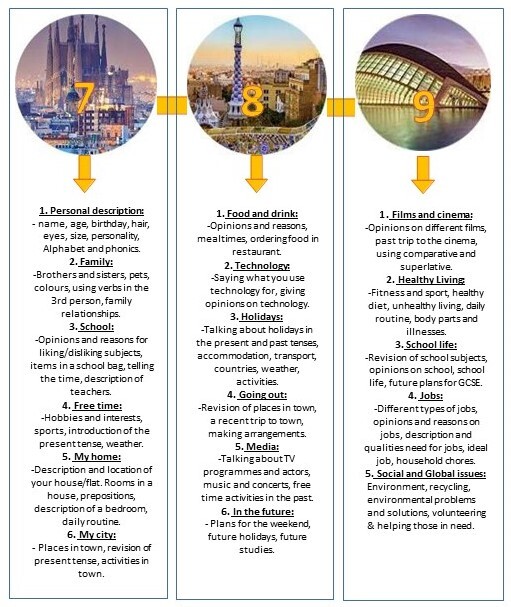
Assessment
Throughout Key Stage 3, students will be continuously assessed during lesson time. The aim of the assessments is to provide students with the opportunities to acquire and develop the skills that will prepare them for sitting the GCSE examinations. The assessed pieces of work will include:
- Translations (from English to Spanish and Spanish to English.
- Reading and Listening exercises.
- Short writing tasks (between 40 and 90 words)
- Role-play and Photo card speaking exams.
These assessments will be marked in line with the GCSE marking criteria, adapted for each year group.
Homework
Students will receive one piece of homework every 3 weeks. The homework will aim to consolidate and extend the students’ learning. Homework must be recorded in their school planner, with the correct instructions and deadlines.
The tasks will range from reading exercises, translations, short writing tasks and research assignments. It may also involve some online learning, via www.quizlet.com, or www.senecalearning.com.
On top of this, it is highly recommended that students spend some time revising the vocabulary learnt after every lesson, in order to make better progress.
KS4 Examinations in 2025
GCSE Spanish builds on the knowledge and skills acquired throughout Key Stage 3, with a range of topics which aim to expand students’ cultural knowledge.
Students will be tested in listening, reading, speaking and writing and will develop transferable skills, relevant to further study and the world of work. The range of topics aims to inspire students who are interested in Spanish culture and Spanish speaking countries.
Areas of study
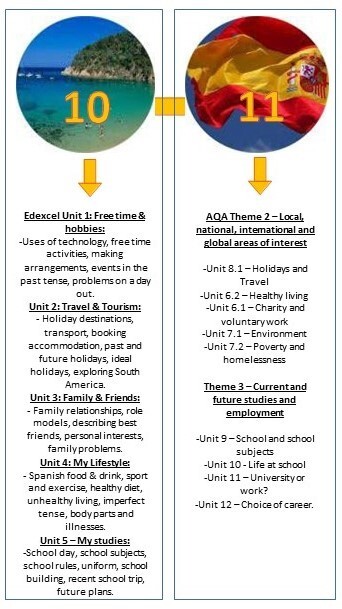
During Key Stage 4, Spanish students will study the following themes and topics:
Theme 1: Identity and Culture
Theme 2: Local, national, international and global areas of interest
Theme 3: Current and future studies and employment
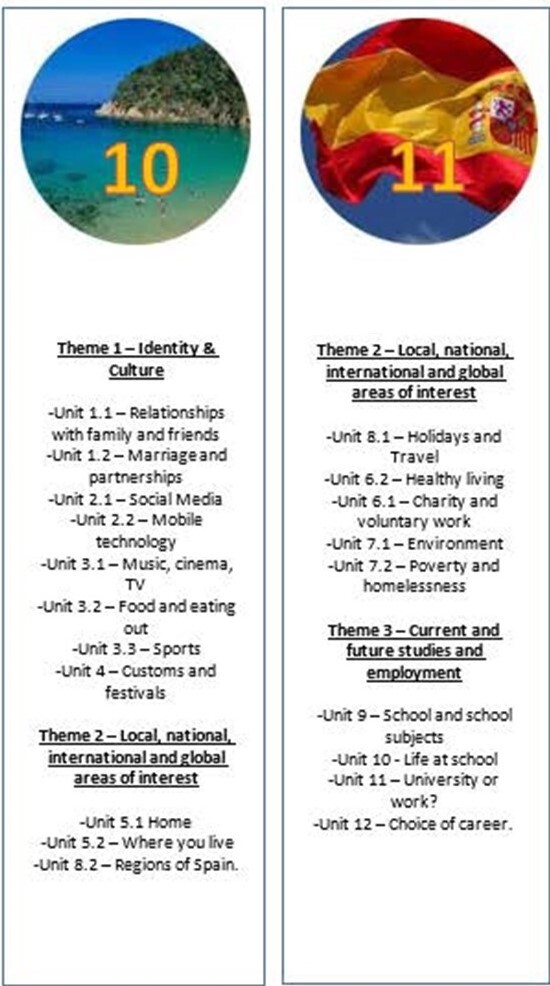
Specification details
Please click here to view full information on the AQA GCSE Spanish specification.
Scheme of Assessment
The GCSE course is split into two tiers, Higher and Foundation. On the Higher tier, students can access grades from 3 to 9, and on the Foundation Tier, students can access grades from 1 to 5. Students must take all four question papers from the same tier.
All examinations will take place during the examination period towards the end of Year 11, starting with the speaking examination.
| Paper 1: Listening |
| · Written exam: 35 minutes (Foundation Tier), 45 minutes (Higher Tier)
· 40 marks (Foundation Tier), 50 marks (Higher Tier) · 25% of GCSE (Each exam includes 5 minutes’ reading time of the question paper before the listening stimulus is played.) |
| Questions
Foundation Tier and Higher Tier · Section A – questions in English, to be answered in English or non-verbally · Section B – questions in Spanish, to be answered in Spanish or non-verbally |
| Paper 2: Speaking |
| · Non-exam assessment
· 7–9 minutes (Foundation Tier) + preparation time · 10–12 minutes (Higher Tier) + preparation time · 60 marks (for each of Foundation Tier and Higher Tier) · 25% of GCSE |
| Questions
Foundation Tier and Higher Tier · Role-play – 15 marks (2 minutes at Foundation Tier; 2 minutes at Higher Tier) · Photo card – 15 marks (2 minutes at Foundation Tier; 3 minutes at Higher Tier) · General conversation – 30 marks (3–5 minutes at Foundation Tier; 5–7 minutes at Higher Tier) |
| Paper 3: Reading |
| · Written exam: 45 minutes (Foundation Tier), 1 hour (Higher Tier)
· 60 marks (for each of Foundation Tier and Higher Tier) · 25% of GCSE |
| Questions
Foundation Tier and Higher Tier · Section A – questions in English, to be answered in English or non-verbally · Section B – questions in Spanish, to be answered in Spanish or non-verbally · Section C – translation from Spanish into English (a minimum of 35 words at Foundation Tier and 50 words at Higher Tier) |
| Paper 4: Writing |
| · Written exam: 1 hour (Foundation Tier), 1 hour 15 minutes (Higher Tier)
· 50 marks at Foundation Tier and 60 marks at Higher Tier · 25% of GCSE |
| Questions
Foundation Tier · Question 1 – four short sentences describing a photo – 8 marks · Question 2 – 4 bullet points, 40 words – 16 marks · Question 3 – translation from English into Spanish (minimum 35 words) – 10 marks · Question 4 – four bullet points, 90 words – 16 marks Higher Tier · Question 1 – four bullet points, 90 words – 16 marks – 16 marks · Question 2 – open-ended writing task – two bullet points, 150 words – 32 marks · Question 3 – translation from English into Spanish (minimum 50 words) – 12 marks |
Revision Guides
Recommended GCSE texts or revision guides:
GCSE Spanish AQA Revision Guide - for the Grade 9-1 Course (with Online Edition)
ISBN: 9781782945468
GCSE Spanish AQA Exam Practice Workbook - for the Grade 9-1 Course
ISBN: 9781782945475
New Grade 9-1 GCSE Spanish Translation Skills Workbook
ISBN: 9781789080513
Homework
Students will receive one piece of homework every 2 weeks. The tasks will range from reading exercises, exam-style translations, exam-style writing questions and research assignments. It may also involve some online learning, via www.quizlet.com, or www.senecalearning.com.
Homework must be recorded in their school planner, with the correct instructions and deadlines.
On top of this, it is highly recommended that students spend around 45 minutes per week, revising vocabulary covered in class, as well as from the GCSE Vocabulary list (found here).
NEW GCSE - starting teaching in September 2024
Specification details
Please click here to view full information on the AQA GCSE Spanish specification.
Scheme of Assessment
The GCSE course is split into two tiers, Higher and Foundation. On the Higher tier, students can access grades from 3 to 9, and on the Foundation Tier, students can access grades from 1 to 5. Students must take all four question papers from the same tier.
All examinations will take place during the examination period towards the end of Year 11, starting with the speaking examination.
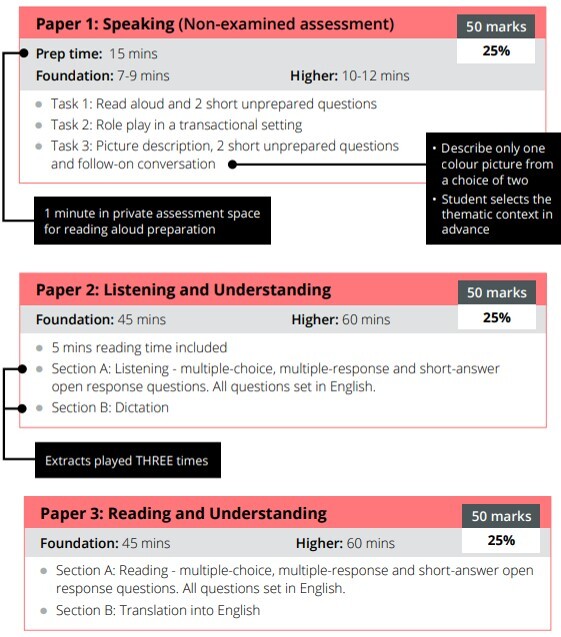

Visual Curriculum Map
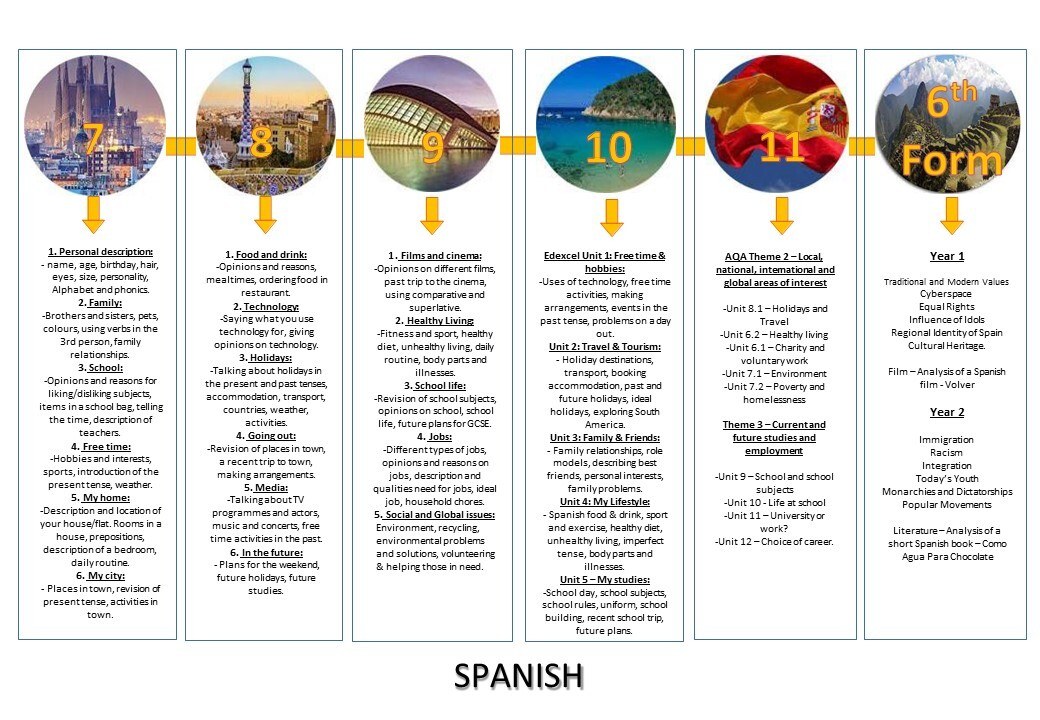
Useful Links
The following are useful websites to help students with various aspects of the course.
www.spanishdict.com – Extremely useful for helping explain and practice the use of different tenses and grammar structures.
www.quizlet.com – An excellent online program that helps students to learn and revise relevant phrases and vocabulary
www.senecalearning.com – Another great, free online program that has ready-made courses for both Key Stage 3 and 4, covering all four skills.
www.sentencebuilders.com – a perfect website for practising the Spanish language, covering topics from beginner level at Key Stage 3 to Grade 9 at GCSE. Your child will have an individual username and password for this website, which will be issued by the class teacher.
www.language-gym.com – a great website for practising key vocabulary across all topics, at all levels. Your child will have an individual username and password for this website, which will be issued by the class teacher.


